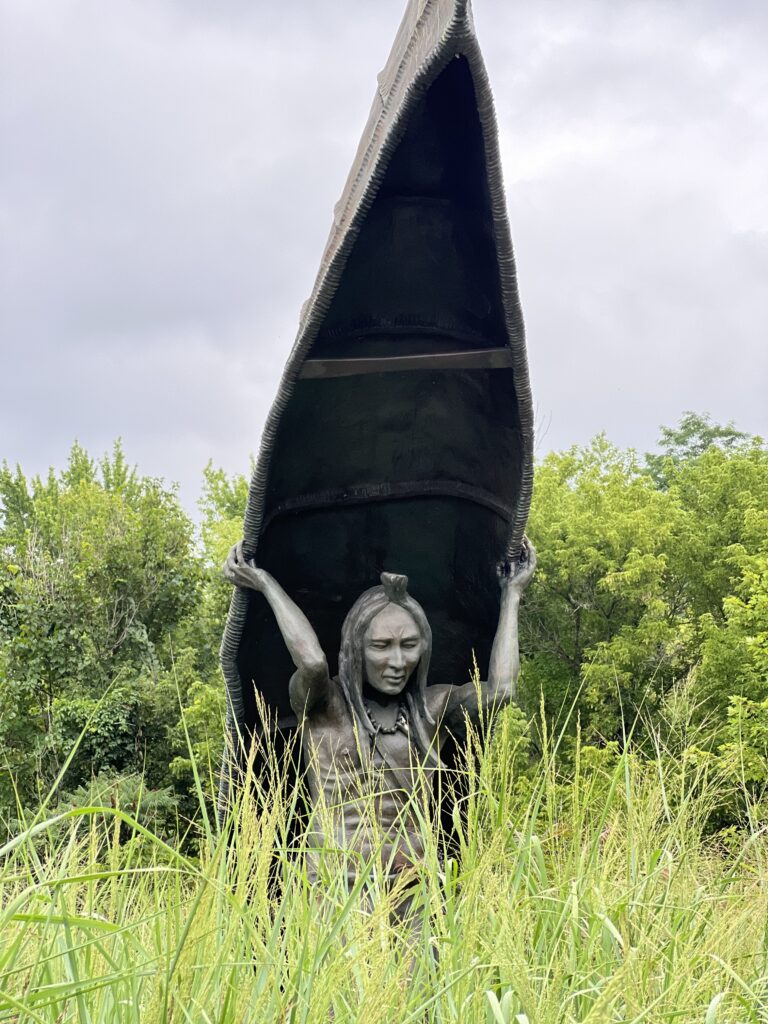
A Sculpture by Internationally-Renowned Artist Peter B. Jones is Coming to Front Street this Fall
By Grace Carter
Peter B. Jones is the internationally-renowned Onondaga artist who created a statue that many Akronites know fondly. The bronze-cast Native American man hoisting a canoe, located on the corner of Merriman Road and North Portage Path, helps engage passersby with the history of the region. Now, a new public art initiative is bringing Jones’ work to downtown Cuyahoga Falls.
Jones attended the Institute of American Indian Art in New Mexico and studied under the direction of Hopi artist Otellie Loloma. Jones’ art resembles early Iroquois pottery and reflects issues that have impacted the Haudenosaunee people. His workshop is in the Cattaraugus Territory and he lives on the Allegheny Territory of the Seneca Nation of Indians in New York.
Roughly two decades after completing the sculpture located at the Portage Path, Jones is creating another large, bronze-cast sculpture for the City of Cuyahoga Falls. The City received an Our Town grant from the National Endowment for the Arts and used the funding to commission Jones to create the sculpture, which will be installed on Levinson Lane, between Front Street and Second Street, in the fall of 2022.
Every year, Jones returns to Akron for North American First People’s Day. He gives an annual talk to school-age children about his sculpture on the Portage Path in collaboration with Summit County Historical Society member Dave Lieberth. Jones believes it is helpful to introduce children to work done by a Native person because he grew up on a reservation that was very poor and it was harder to see what could be achieved.
Jones learned more about the Cuyahoga River when he created the Portage Path piece, which was completed in 2001. He did research on the Cuyahoga River and became interested in its thoroughfare. He discovered that the rivers were useful as trade routes. Jones based the 2001 sculpture on this history. Jones was surprised by how large the falls are, and this intrigued him. He decided he wanted to show the dangers of the river trade through his sculptures.

Jones’ Summit County sculptures can help people understand why the Native population is so low in the region. There are no federally recognized reservations in Ohio. Many Natives left Ohio or were forced out by westward expansion. The Portage Trail connects the rivers and was an exchange place and main thoroughfare for trade. It could be used to access the Mississippi River and the Allegheny River.
The statue for downtown Cuyahoga Falls will be slightly smaller than the one on the Portage Path. It depicts a Native river trader in a canoe. The Cuyahoga River is treacherous in certain spots because of the rocks, so Jones’ vision is that the river trader is navigating the waters and keeping afloat.
When it comes to creating large-scale, outdoor bronze-cast sculptures, it is helpful to have support. Jones made some small bronze castings when he was in school but did not pursue it very much on his own due to the financial cost. He explains that as an independent artist, it is challenging to garner the kind of backing necessary to complete those types of projects. The sculpture for the Portage Trail was funded by William Yeck, a patron who had an interest in the Native peoples who lived in the Akron area. The sculpture took about five years to complete (1996-2001).
The Our Town grant is Jones’ first NEA-funded project. Currently, he is also working on a concrete canoe with his son which will be installed at the Ganondagan State Historic Site, a Native American historic site in New York. It is the location of the largest Seneca village of the 17th century and is in the present-day Town of Victor. The piece tells the story of the founding of the Iroquois Confederacy and a peacemaker who traveled in a stone canoe and spread the word about peace to all the tribes in western New York. Concrete is a new medium for Jones, and he is building the piece on-site.